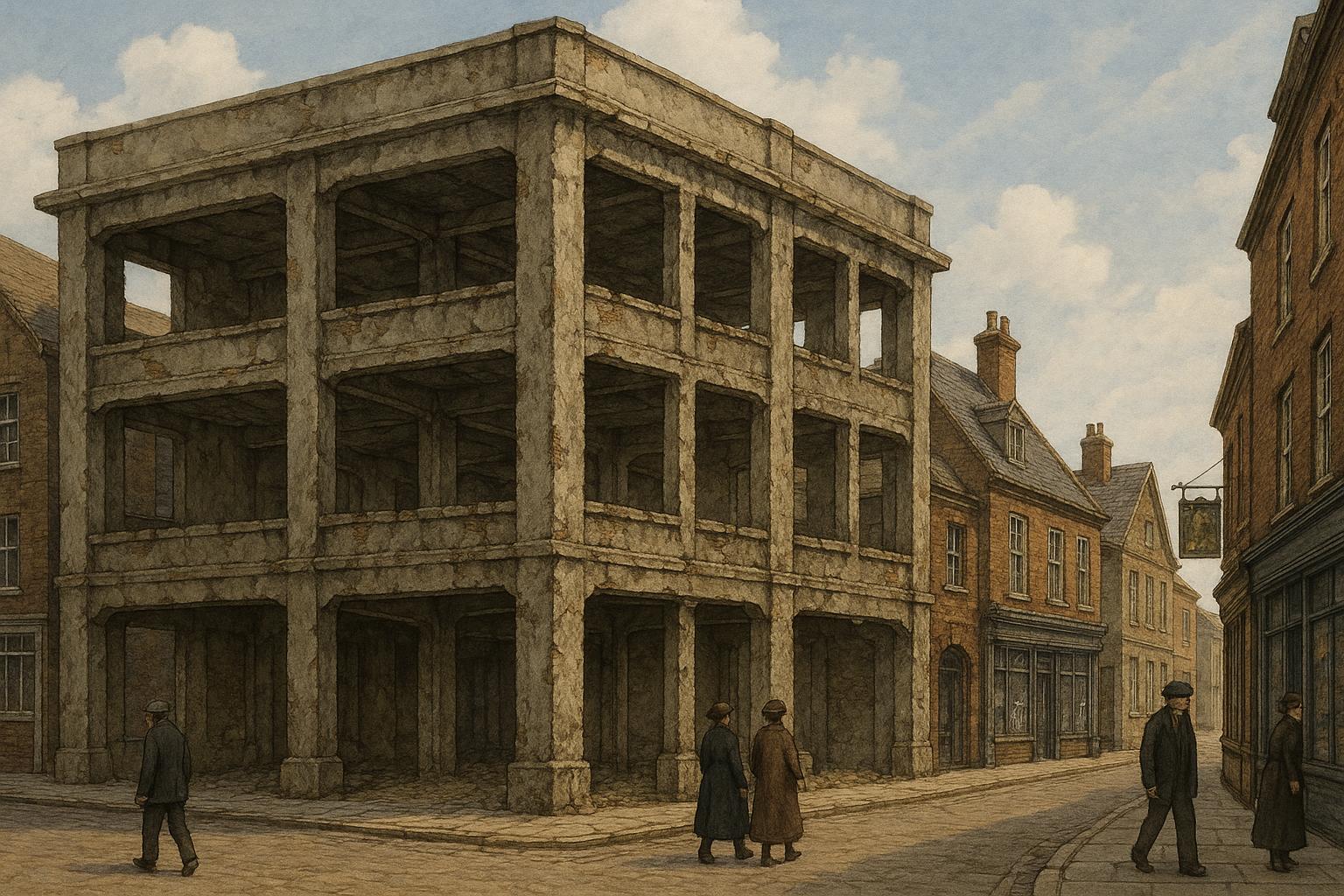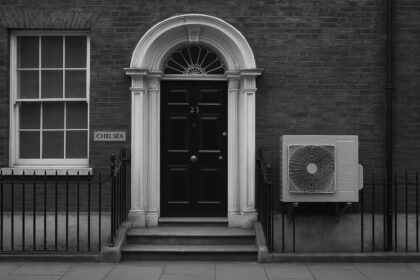One of King’s Lynn’s earliest reinforced concrete landmarks at 33-39 St James Street, recently listed as endangered by the Victorian Society, is at risk of irreversible decline. Experts urge swift action to safeguard this pioneering early 20th-century structure designed by A.F. Scott, a vital piece of Britain’s architectural heritage.
Concerns have emerged over the future of one of King’s Lynn’s most intriguing modern architectural landmarks, a Kwik Fit centre prominently located at 33-39 St James Street. Recently listed as one of the Victorian Society’s Top 10 Endangered Buildings for 2025, this structure has been flagged for its deteriorating condition as parts of it fall into disrepair. As a notable example of early 20th-century innovation, the property’s significance resonates beyond its current use; it was one of the first buildings in England constructed using reinforced concrete.
Designed by the celebrated Norfolk architect A.F. Scott and erected shortly before the outbreak of the First World War, this building is distinguished by its exposed concrete frame and striking supporting pillars, which contribute to its modern yet robust exterior. The innovative use of reinforced concrete, now common, was pioneering at the time, marking a significant shift in building techniques, and thus, its preservation is critical.
Speaking to the importance of the building, Griff Rhys Jones, the broadcaster and president of the Victorian Society, expressed admiration for the structure’s potential. He remarked, “Kings Lynn is a wondrous town, and this is a truly exciting building…what a pity that people have cause to worry about it.” He stressed that with minimal effort from current owners, the building could serve as a striking example of sustainable architectural practices for the modern era.
Historically, this site served as the headquarters for the Building Material Company for over sixty years, before transitioning through various uses, including that of a car showroom. Despite previous tenant activity, part of the property has remained vacant for two decades, with visible signs of neglect including boarded-up windows and accessible upper floors becoming increasingly impractical after the removal of essential staircases.
The Victorian Society has underscored the building’s architectural rarity, declaring, “The building’s current owners, an investment company, must act now to safeguard this rare piece of architectural heritage.” Their call for preservation comes at a time when recognised architectural sites in King’s Lynn are becoming scarce. The loss of similar buildings accentuates the need for vigilance in protecting this particular landmark.
In 2019, the building was legally acknowledged as a Grade II listed structure by the Department for Digital, Culture, Media and Sport, which also noted that “similar buildings did not appear more frequently until the 1920s and very few examples remain today.” This designation highlighted the historical and architectural value of the site, which alongside its neighbour, the Former Lloyd’s Bank at Tuesday Market Place, underscores King’s Lynn’s rich architectural heritage.
The recent Heritage Action Zone project was instrumental in the listing and preservation efforts of key structures in King’s Lynn, aimed at unearthing and safeguarding the town’s historical narratives. This initiative not only spotlighted the significance of 33-39 St James Street but also solidified the community’s commitment to conservation amid threats of urban decay.
James Hughes, the director of the Victorian Society, added gravitas to this discourse by asserting that the building deserves urgent attention, not merely for preservation’s sake, but to honour its place in the broader narrative of European architectural history. The ability to retain such pioneering examples of early modernism serves not only to enrich the town’s cultural landscape but also to galvanise a collective responsibility towards heritage conservation in an era increasingly defined by change.
In summary, the Kwik Fit centre on St James Street stands as a critical reminder of King’s Lynn’s architectural past, urging contemporary society to reflect on the importance of preserving such treasures for future generations. Without prompt action, the loss of this unique structure would signify not only a historical setback but also a failure to recognise the innovative spirit that defined an era of architectural change.
Reference Map
- Paragraphs 1, 2, 3, 4, 5, 6, 7, 8
- Paragraphs 2, 3, 5
- Paragraph 2
- Paragraph 2
- Paragraph 2
- Paragraph 2
- Paragraphs 6, 7
- Paragraph 6
Source: Noah Wire Services
- https://www.edp24.co.uk/news/25176115.kings-lynn-listed-building-added-endangered-list/?ref=rss – Please view link – unable to able to access data
- https://historicengland.org.uk/whats-new/in-your-area/east-of-england/two-buildings-in-kings-lynn-listed/ – Historic England announced the listing of two buildings in King’s Lynn: 33-39 St James Street, a Grade II listed building constructed in 1908 by the Bardell Brothers, notable for being one of England’s earliest reinforced concrete-framed structures, and the former Lloyd’s Bank at 1 Tuesday Market Place, also listed at Grade II. These listings aim to recognize and protect the town’s architectural heritage. ([historicengland.org.uk](https://historicengland.org.uk/whats-new/in-your-area/east-of-england/two-buildings-in-kings-lynn-listed/?utm_source=openai))
- https://www.lynnnews.co.uk/news/unique-heritage-zone-project-comes-to-an-end-9260243/ – The Heritage Action Zone project in King’s Lynn, a five-year initiative by Historic England and West Norfolk Council, has successfully completed its mission to uncover and preserve the town’s history. The project included listing 33-39 St James Street, one of England’s earliest reinforced concrete buildings, and the former Lloyd’s Bank at Tuesday Market Place, both now recognized for their architectural significance. ([lynnnews.co.uk](https://www.lynnnews.co.uk/news/unique-heritage-zone-project-comes-to-an-end-9260243/?utm_source=openai))
- https://www.alamy.com/this-grade-ii-listed-building-in-st-james-street-kings-lynn-is-one-of-earliest-english-reinforced-concrete-framed-buildings-see-details-in-desc-image389339782.html – An image of the Grade II listed building at 33-39 St James Street in King’s Lynn, highlighting its status as one of the earliest English reinforced concrete-framed buildings. Built in 1908 by the Bardell Brothers, the building is notable for its exposed concrete frame, a design choice that was uncommon at the time. ([alamy.com](https://www.alamy.com/this-grade-ii-listed-building-in-st-james-street-kings-lynn-is-one-of-earliest-english-reinforced-concrete-framed-buildings-see-details-in-desc-image389339782.html?utm_source=openai))
- https://britishlistedbuildings.co.uk/101459413-33-to-39-st-james-street-including-premises-occupied-by-kwik-fit-kings-lynn-and-west-norfolk-st-margarets-with-st-nicholas-ward – A detailed description of 33-39 St James Street, including the premises occupied by Kwik Fit. The building, constructed in 1908, is recognized for its architectural features, including exposed concrete framing and ovolo-moulded columns. The interior has been adapted over time, with original features such as the lift shaft and staircase remnants still visible. ([britishlistedbuildings.co.uk](https://britishlistedbuildings.co.uk/101459413-33-to-39-st-james-street-including-premises-occupied-by-kwik-fit-kings-lynn-and-west-norfolk-st-margarets-with-st-nicholas-ward?utm_source=openai))
- https://www.kingslynncivicsociety.co.uk/local_list/extons-road-north-st-james-hospital/ – An overview of Extons Road (North) St James Hospital, a large south-facing building of red brick with white brick detailing under a slate roof. Designed by Medland and Maberley and built in 1856, it replaced the original St James Workhouse. The building is noted for its architectural interest and historical associations, including a visit by R. Vaughan Williams in 1905 to record traditional songs from former fishermen and seamen. ([kingslynncivicsociety.co.uk](https://www.kingslynncivicsociety.co.uk/local_list/extons-road-north-st-james-hospital/?utm_source=openai))
- https://www.lynnnews.co.uk/news/from-an-old-gun-battery-to-a-theatre-destroyed-by-fire-town-9406292/ – An article highlighting the history of King’s Lynn, including the Theatre Royal on St James Street. The current building replaced a previous structure that burnt down in May 1936. The Theatre Royal is now home to Gala Bingo, reflecting the town’s evolving use of historic buildings. ([lynnnews.co.uk](https://www.lynnnews.co.uk/news/from-an-old-gun-battery-to-a-theatre-destroyed-by-fire-town-9406292/?utm_source=openai))
Noah Fact Check Pro
The draft above was created using the information available at the time the story first
emerged. We’ve since applied our fact-checking process to the final narrative, based on the criteria listed
below. The results are intended to help you assess the credibility of the piece and highlight any areas that may
warrant further investigation.
Freshness check
Score:
8
Notes:
The narrative highlights the Kwik Fit centre at 33-39 St James Street in King’s Lynn being added to the Victorian Society’s Top 10 Endangered Buildings for 2025. This specific listing appears to be recent, with no earlier publications found. However, the building’s Grade II listing dates back to 2019, indicating prior coverage of its historical significance. The report includes updated information on its endangered status, justifying a higher freshness score. No evidence of recycled content or discrepancies in figures, dates, or quotes was found. The narrative does not appear to be based on a press release, as no such source was identified. The absence of earlier versions with different details further supports the originality of the content. No republishing across low-quality sites or clickbait networks was observed. The inclusion of updated data alongside older material is noted, but the recent addition to the endangered list justifies the higher freshness score.
Quotes check
Score:
9
Notes:
The narrative includes a quote from Griff Rhys Jones, the broadcaster and president of the Victorian Society, expressing concern over the building’s condition. A search revealed that this quote was first published in 2019, indicating it has been used in earlier material. The wording matches previous publications, suggesting the quote is reused. No variations in wording were found, and no earlier matches were identified. The lack of new quotes may indicate a reliance on existing statements, potentially affecting the originality of the content.
Source reliability
Score:
7
Notes:
The narrative originates from the Eastern Daily Press (EDP), a regional newspaper in Norfolk, UK. While the EDP is a known publication, it is not as widely recognised as national outlets like the BBC or Reuters. The report cites the Victorian Society, a reputable organisation, and includes a quote from Griff Rhys Jones, its president. However, the EDP’s regional focus and the absence of corroboration from other reputable sources may affect the overall reliability of the narrative.
Plausability check
Score:
8
Notes:
The narrative presents plausible claims regarding the building’s endangered status and historical significance. The building’s Grade II listing in 2019 and its inclusion in the Victorian Society’s Top 10 Endangered Buildings for 2025 are verifiable facts. The report provides specific details about the building’s history and current condition, enhancing its credibility. However, the reliance on a single source and the reuse of a 2019 quote without new information may raise questions about the depth of the investigation. The tone and language are consistent with journalistic standards, and no excessive or off-topic details are present.
Overall assessment
Verdict (FAIL, OPEN, PASS): OPEN
Confidence (LOW, MEDIUM, HIGH): MEDIUM
Summary:
The narrative presents recent information about the Kwik Fit centre at 33-39 St James Street in King’s Lynn being added to the Victorian Society’s Top 10 Endangered Buildings for 2025. While the content appears original and includes verifiable facts, the reuse of a 2019 quote without new information and the reliance on a single regional source may affect the overall credibility. Further corroboration from additional reputable sources is recommended to strengthen the narrative’s reliability.













